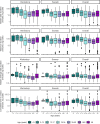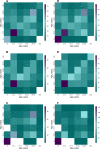Association of close-range contact patterns with SARS-CoV-2: a household transmission study
- PMID: 37461328
- PMCID: PMC10359094
- DOI: 10.7554/eLife.84753
Association of close-range contact patterns with SARS-CoV-2: a household transmission study
Abstract
Background: Households are an important location for severe acute respiratory syndrome coronavirus 2 (SARS-CoV-2) transmission, especially during periods when travel and work was restricted to essential services. We aimed to assess the association of close-range contact patterns with SARS-CoV-2 transmission.
Methods: We deployed proximity sensors for two weeks to measure face-to-face interactions between household members after SARS-CoV-2 was identified in the household, in South Africa, 2020-2021. We calculated the duration, frequency, and average duration of close-range proximity events with SARS-CoV-2 index cases. We assessed the association of contact parameters with SARS-CoV-2 transmission using mixed effects logistic regression accounting for index and household member characteristics.
Results: We included 340 individuals (88 SARS-CoV-2 index cases and 252 household members). On multivariable analysis, factors associated with SARS-CoV-2 acquisition were index cases with minimum Ct value <30 (aOR 16.8 95% CI 3.1-93.1) vs >35, and female contacts (aOR 2.5 95% CI 1.3-5.0). No contact parameters were associated with acquisition (aOR 1.0-1.1) for any of the duration, frequency, cumulative time in contact, or average duration parameters.
Conclusions: We did not find an association between close-range proximity events and SARS-CoV-2 household transmission. Our findings may be due to study limitations, that droplet-mediated transmission during close-proximity contacts plays a smaller role than airborne transmission of SARS-CoV-2 in the household, or due to high contact rates in households.
Funding: Wellcome Trust (Grant number 221003/Z/20/Z) in collaboration with the Foreign, Commonwealth, and Development Office, United Kingdom.
Keywords: SARS-CoV-2; contacts; epidemiology; global health; household; infectious disease; microbiology; transmission; viruses.
© 2023, Kleynhans et al.
Conflict of interest statement
JK reports institutional grant funding from UK Foreign, Commonwealth and Development Office, Wellcome Trust, WHO AFRO, Africa Pathogen Genomics Initiative (Africa PGI) through African Society of Laboratory Medicine (ASLM) and Africa CDC, US Centers for Disease Control and Prevention, South African Medical Research Council (SAMRC) and UK Department of Health and Social Care and managed by the Fleming Fund: SEQAFRICA project. The author has no other competing interests to declare, LD received support from the European Union's Horizon 2a020 research and innovation programme under grant agreements No. 101003688 (EpiPose) and No. 101016233 (PERISCOPE). The author acknowledges support from the Lagrange Project of ISI Foundation funded by CRT Foundation. They were awarded a PhD contract with Grenoble INP, and received support for attending meetings/travel from the ISP Foundation and Grenoble INP. The author has no other competing interests to declare, LG has received Payment or honoraria for lectures from the University of Torino, Italy. They received support from the Lagrange Project of ISI Foundation funded by CRT Foundation. The authors has no other competing interests to declare, MT acknowledges support from the Lagrange Project of ISI Foundation funded by CRT Foundation, LM, MM, ST No competing interests declared, SW reports institutional grant funding from WHO AFRO, Africa Pathogen Genomics Initiative (Africa PGI) through African Society of Laboratory Medicine (ASLM) and Africa CDC, US Centers for Disease Control and Prevention, South African Medical Research Council (SAMRC), UK Department of Health and Social Care and managed by the Fleming Fund: SEQAFRICA project and the Wellcome Trust. The author has no other competing interests to declare, NM received grant funds from Pfizer. They participated on the data safety monitoring board of a TB HDT trial, and on the Scientific Advisory Board of a trial of an electronic reminder to take daily TB treatment. They hold an unpaid leadership role at the Setshaba Research Center. The authors has no other competing interests to declare, Av reports receiving grant funds from Sanofi Pasteur and Bill & Melinda Gates Foundation. They act as chairperson of the National Advisory Group on Immunisation. The author has no other competing interests to declare, NW received grants from Sanofi Pasteur and Bill & Melinda Gates Foundation, and from US Centers for Disease Control and Prevention. The author has no other competing interests to declare, CC has received grant support from Sanofi Pasteur, US Centers for Disease Control and Prevention, Welcome Trust, Programme for Applied Technologies in Health (PATH), Bill & Melinda Gates Foundation and South African Medical Research Council (SA-MRC). The author has no other competing interests to declare, CC received support from the European Union's Horizon 2020 research and innovation programme under grant agreements No. 101003688 (EpiPose) and No. 101016233 (PERISCOPE), and from Fondation Botnar, EPFL COVID-19 Real Time Epidemiology I-DAIR Pathfinder. They also received support from the Lagrange Project of ISI Foundation funded by CRT Foundation, and received equipment from the European Space Agency. They were issued the patent US8660490B2. They received support for attending meetings/travel from Gulbenkian Foundation, and participate as a Steering Board Member at CRT Foundation, on the Advisory Board at The Data Guild and on the Advisory Board in GovLab's 100 Questions Initiative and Open Data Policy Lab. The authors has no other competing interests to declare
Figures




Update of
- doi: 10.1101/2022.12.22.22283843
References
-
- Aleta A, Martín-Corral D, Bakker MA, Pastore Y Piontti A, Ajelli M, Litvinova M, Chinazzi M, Dean NE, Halloran ME, Longini IM, Jr, Pentland A, Vespignani A, Moreno Y, Moro E. Quantifying the importance and location of SARS-Cov-2 transmission events in large metropolitan areas. PNAS. 2022;119:e2112182119. doi: 10.1073/pnas.2112182119. - DOI - PMC - PubMed
-
- Bingham J, Cable R, Coleman C, Glatt TN, Grebe E, Mhlanga L, Nyano C, Pieterson N, Swanevelder R, Swarts A, Sykes W, van den Berg K, Vermeulen M, Welte A. Estimates of prevalence of anti-sars-cov-2 antibodies among blood donors in south africa in march 2022. Research Square. 2022 doi: 10.21203/rs.3.rs-1687679/v1. - DOI
Publication types
MeSH terms
Grants and funding
LinkOut - more resources
Full Text Sources
Medical
Miscellaneous

